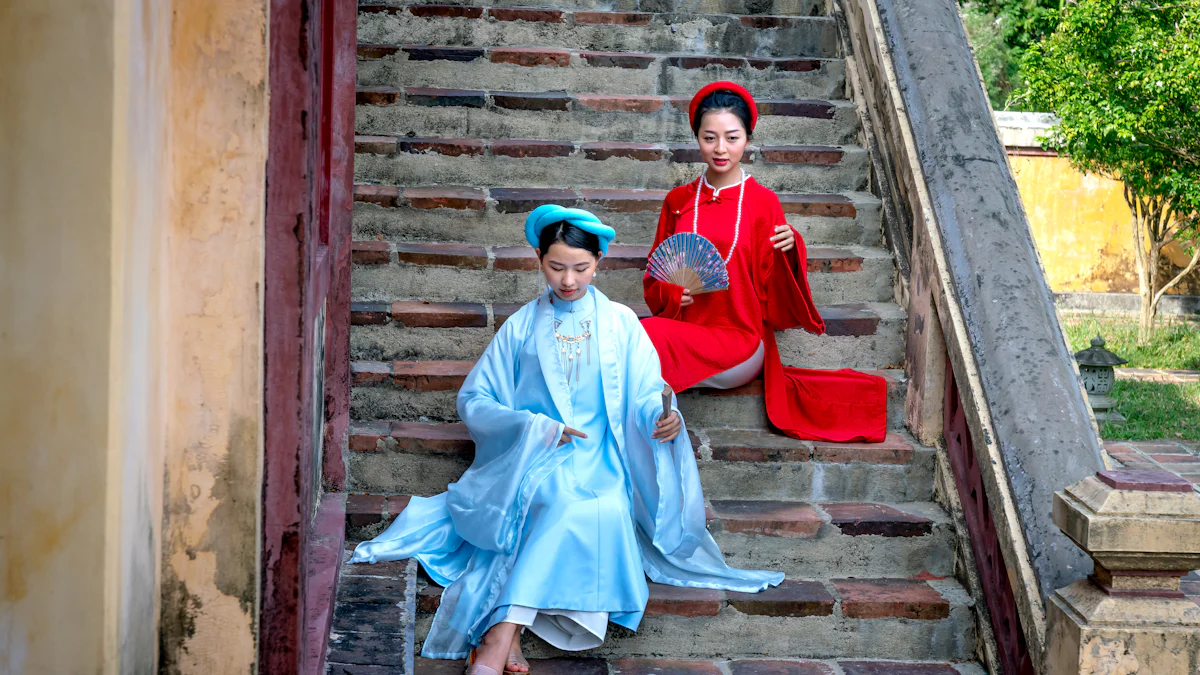
The comparison between Hanfu and Kimono unveils a captivating narrative of cultural exchange and sartorial elegance. The origins and basic characteristics of these traditional garments reflect the intertwined histories of China and Japan. Influenced by early Chinese clothing, the evolution of Kimono during the 8th century showcases the enduring impact of Hanfu on Japanese fashion. Similarly, Hanfu’s historical roots date back to ancient dynasties, shaping its distinctive silhouette and design. Exploring these timeless attires illuminates the rich tapestry of cultural heritage shared between China and Japan.
Historical Roots and Evolution
The Origins of Hanfu
The origins of Hanfu can be traced back to the rich tapestry of ancient Chinese dynasties, particularly finding its roots in the Han Dynasty. During this period, Hanfu underwent a significant evolution, introducing wider sleeves, longer robes, vibrant colors, and intricate embroidery. This marked a pivotal shift in the design and aesthetic of traditional Chinese attire, reflecting the cultural and artistic influences prevalent during that era.
Throughout its evolution from the Shang Dynasty to the Ming Dynasty, Hanfu experienced diverse influences that shaped its design. The introduction of new ceremonial clothing, linen robes, and a shift towards simplicity and practicality further exemplified the adaptability and cultural significance of Hanfu. Notably, historical records underscore the profound significance of Hanfu in Chinese history, with its origins tracing back to the influential reign of Emperor Wu of Han. The evolution of Hanfu through various dynasties introduced elements such as basic tunics and robes, cross-collar garments, vibrant colors, and luxurious materials like silk.
The independent development of Hanfu over centuries underscores its enduring legacy as an integral part of China’s cultural heritage. From its establishment in the Shang Dynasty to its prevalence during the Qin and Han dynasties, Hanfu has remained a symbol of elegance and tradition throughout China’s history.
The Development of the Kimono
In contrast to Hanfu, the development of Kimono reflects Japan’s unique sartorial journey. With an independent trajectory from its early origins to contemporary times, Kimono encompasses indigenous clothing traditions spanning over 3000 years of history. The establishment of its basic form during ancient periods laid the foundation for Kimono’s distinctive silhouette and design.
During periods such as Heian up to modern times, Kimono underwent notable transformations in style and craftsmanship. The preservation of traditional techniques alongside contemporary adaptations has contributed to Kimono’s enduring allure as a symbol of Japanese culture. This steadfast commitment to preserving cultural identity through attire is evident in both ceremonial occasions and everyday life.
The evolution from ancient dynasties to modern-day showcases how both Hanfu and Kimono have transcended time while retaining their timeless elegance and cultural significance.
Aesthetic Differences and Styling
As the exploration of Hanfu and Kimono continues, it becomes evident that their aesthetic differences and styling play a pivotal role in defining their cultural significance.
Hanfu vs Kimono: Fabric and Design
Colors, Patterns, and Materials
The fabric, design, and materials used in crafting Hanfu and Kimono reflect the distinct artistic sensibilities of Chinese and Japanese traditions. Hanfu emphasizes layered and flowing design with cross-collar robes made from silk, linen, and hemp. These fabrics are adorned with motifs like dragons, phoenixes, and floral patterns, signifying various cultural values. On the other hand, Kimonos also favor silk but incorporate a broader range of materials including cotton and synthetic fabrics. The designs can range from simple, understated patterns to elaborate, vibrant imagery. This diversity in fabric choices underscores the rich tapestry of cultural expression embedded within these traditional garments.
Hanfu vs Kimono: Traditional Accessories
Enhancing the Outfit
In addition to fabric and design differences, traditional accessories further distinguish Hanfu from Kimono. Hanfu features a slimmer and higher waistline with a cross-collar design compared to kimono’s T-shaped silhouette with straight-lined robes. The length of Hanfu robes is generally longer with lower side slits compared to kimono’s above-ankle length. Moreover, Hanfu typically has a wrap-over right lapel while kimono has a left lapel fold. The sleeves of Hanfu are much wider and looser than those of the fitted kimono sleeves. Furthermore, while Kimonos often use an Obi belt to secure the dress around the waist, Hanfu does not incorporate this accessory into its design.
The visual clues presented by these traditional accessories serve as tangible representations of the distinctive elements that define each attire’s style. For instance, the sash on Hanfu is typically tied in front while the obi on kimono is typically tied in back. Additionally, the kimono obi is much wider, thicker, and stiffer than the hanfu sash. The sleeves also offer visual cues; kimono sleeves are more rectangular while hanfu sleeves are more curved.
The utilization of these traditional accessories not only enhances the overall aesthetic appeal but also serves as an embodiment of cultural identity within each garment.
Cultural Significance and Modern Influence
Hanfu in Chinese Culture
Rituals and Celebrations
The cultural significance of Hanfu in Chinese society extends beyond its role as traditional attire, encompassing a profound connection to rituals and celebrations. From elaborate ceremonies to festive occasions, Hanfu embodies the timeless elegance and cultural ethos of the Han ethnic group. The intricate designs and symbolic motifs woven into the fabric of Hanfu garments reflect the aesthetics, philosophy, and ethics of traditional Chinese culture. This sartorial heritage is deeply intertwined with historical narratives, spiritual beliefs, and social customs, enriching the tapestry of Chinese traditions.
In contemporary China, the revival of Hanfu has sparked a renewed interest in ancient rituals and ceremonial practices. The resurgence of traditional weddings, coming-of-age ceremonies, and cultural festivals has provided a platform for individuals to embrace their heritage through the graceful drapes of Hanfu. Moreover, the incorporation of Hanfu into modern fashion showcases a harmonious blend of historical reverence and artistic innovation. A 2019 study in fashion design revealed that approximately 30% of contemporary Kimono patterns exhibit elements reminiscent of traditional Chinese aesthetics, particularly those found in Hanfu. This cultural exchange illustrates a fascinating aspect of fashion evolution and serves as a testament to the enduring allure of Hanfu.
The enduring legacy of Hanfu continues to resonate within Chinese culture as an embodiment of grace, dignity, and cultural pride.
Kimono in Japanese Society
Symbolism and Contemporary Use
The Kimono holds a revered position within Japanese society as a symbol steeped in historical significance and contemporary relevance. Its rich symbolism transcends mere sartorial elegance; it encapsulates historical narratives, spiritual values, and social customs unique to Japan. The evolution from ancient dynasties to modern-day showcases how both Hanfu and Kimono have transcended time while retaining their timeless elegance and cultural significance.
Furthermore, while the kimono is a Japanese garment, the cultural conversation between both China and Japan influenced how the garment changed over time to become the modern kimono we see today. This interplay between cultures highlights an intriguing aspect of fashion evolution that celebrates influences from diverse traditions.
In contemporary Japan, the Kimono continues to be an emblematic attire for various ceremonial occasions such as weddings, tea ceremonies (chanoyu), coming-of-age ceremonies (Seijin no Hi), and other significant cultural events. The meticulous craftsmanship involved in creating Kimonos reflects an unwavering commitment to preserving traditional techniques alongside contemporary adaptations. Our founders’ family history has influenced each part of these beautiful modern kimono robe designs which celebrate not only Japanese heritage but also honor influences from Chinese kimono designs.
The enduring legacy of Kimono serves as a poignant reminder of Japan’s rich cultural heritage while embracing influences from diverse traditions.
Conclusion: Reflecting on Elegance and Cultural Identity
The Enduring Legacy of Hanfu and Kimono
As traditional clothing plays a significant role in preserving cultural identity and heritage, it reflects the history, identity, and values of a community. The timeless elegance and cultural significance of Hanfu and Kimono are deeply intertwined with emotions and feelings, embodying the philosophical basis that wearing traditional clothing is a way for people to connect with their cultural heritage and express their identity.
Preserving Tradition in the Modern World
The debate around respect, appreciation, and cultural appropriation regarding non-Chinese wearing Hanfu reflects broader dialogues about globalization and cultural exchange. Approaching traditional attires with respect and sensitivity is vital, as wearing another culture’s traditional dress should involve an understanding and appreciation of its significance. It is important to respect and acknowledge the origins of cultural clothing, ensure fair representation, and actively work to preserve traditional techniques.
The modern perspectives and interpretations of the Kimono and Hanfu highlight the complexity and dynamism of traditional attire in contemporary society. They show how these garments are not only historical artifacts but also living elements of culture and identity, continually adapting and evolving in response to modern influences and global trends. Exploring the rich heritage of East Asian traditional clothing reveals a tapestry woven with history, culture, art, values, beliefs, resistance against colonialism, preservation of techniques, education, understanding, respect for cultural significance – all contributing to the enduring legacy of Hanfu and Kimono.
In conclusion, traditional clothing serves as a profound reflection of a community’s history, identity, and values. The cultural significance of Hanfu and Kimono extends beyond mere attire; it embodies the rich tapestry of beliefs, customs, and historical narratives unique to China and Japan. Understanding and respecting the cultural contexts of these traditional attires is crucial in fostering appreciation for diverse cultures. The narrative of shared aesthetics and mutual influence between Hanfu and Kimono highlights the dynamic nature of cultural interaction and its lasting impact on traditional attire. Embracing the elegance and cultural significance of Hanfu and Kimono allows individuals to connect with their heritage while honoring the enduring legacy of East Asian sartorial traditions.






